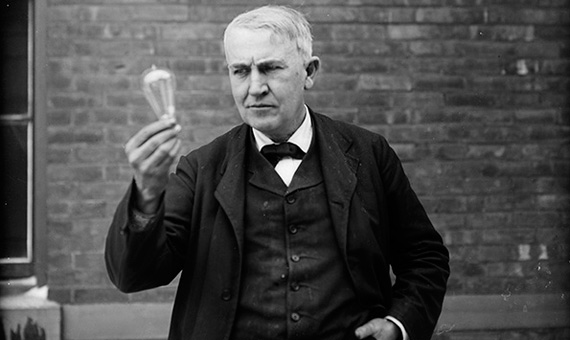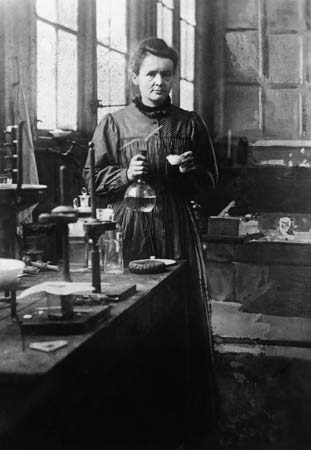Happy National Inventor’s Day!

Could you imagine how different your life would be different if there were no lights? No running water? How about no clocks? No Post-It Notes? No straws? Nearly everything around us is a result of someone thinking outside the box, fiddling around in their basement, garage, or office to fix a problem. Or, as my mother would say, find an easier more efficient way of doing something.
As a way to show these inventors thanks for the time and effort they have put forth to make modern life easier, safer, and, arguably to some, better, February 11 has been designated as National Inventors Day.
Who decided this?

On January 28, 1982 Senator Charles McC. Mathias, Jr. introduced Senate Joint Resolution 140 to the 97th congress (1981-1982) to designate February 11, 1993 as National Inventor Day. In March, it passed in the Senate and in June, passed in the House. On June 21, 1982 President Ronald Reagan signed it and it became Public Law No: 97-198.
On January 12, 1983, President Ronald Reagan declared February 11 as national Inventor’s day, Proclamation 5013, to “…call upon the people of the United States to observe this day with appropriate ceremonies and activities…Just as in George Washington’s day, inventors are the keystone of the technological progress that is so vital to the economic, environmental, and social well-being of this country.”
The date of February 11 was chosen because it is the birthday of Thomas Alva Edison, born in 1847 in Milan, Ohio, and best known for inventing the light bulb and holding over 1,000 patents.
Patent? What is that?
We’ll cover that later, but let’s start at the beginning. Before an inventor can get a patent, they need an invention.
An invention is a unique or original machine or process developed by a person or team. It can be an improvement on something that already exists or a completely brand new design. If an inventor is successful at their attempts, their results may be a major breakthrough. However, it may take many attempts and adjustments to their projects for this to occur, if they are lucky.
Inventors work through trial and error; developing ideas, scrapping them, and starting anew. The initial idea may change form, becoming more simple and practical, expand into a larger design, or change into something completely different. It is a creative process that opens the mind up to look beyond what is in front of them and possibly finding the connections between ideas may make no sense at first glance. This may not happen when an inventor is standing in their workspace. It can happen at any moment, any place, during any other task they may be performing.
Through the process the inventor needs to stay focused on what they may want as their final outcome, which can be hard since they do not know what the final outcome may be with each experiment or if they will be successful. It took Edison 1,000 attempts to make the light bulb. When a reporter asked him how it felt to fail 1,000 times, his response was, “I didn’t fail 1,000 times. The light bulb was an invention with 1,000 steps.”

So, we have created something unique. Time to get a patent?
Patents legally protect an inventor’s work. It will grant exclusive rights to a person or company who invents any new and useful machine, article, or process. The patent creates the right to exclude others from making, using, and selling the inventions, making it subject to a fee. Patents usually last 20 years from the filing date. However, if an invention is an improvement of another patented product, that inventor can patent the improvement but must obtain permission from the original inventor to use it, which can be refused.
The application will contain a description of how to make and use the invention with enough detail for a person skilled in that field to understand. It is then reviewed to see if it meets the requirements of that country’s law, which vary. If denied, the applicant can appeal. If approved, the applicant is subject to renewal fees to keep the patent enforced over time. Currently, it is about $130 for a small object filing fee and $100 to $125 per page for drawings, possibly totaling up to $2,500 to $3,000 for a good quality application.
Now that we know the process, let’s talk about some notable inventors. It is National Inventors Day.
RELATED ~ Tesla’s Wardenclyffe Lab Becomes a World Historical Site
Thomas Edison

Born February 11, 1848, he loved to experiment as a child. He received his first patent on June 1, 1869 for the stock ticker, which later earned him a considerable amount of money. In the 1870’s, he sold the rights to the quadruplex telegraph to Western Union which gave him the financial ability to establish a proper laboratory for his work.
In 1877, Edison developed the phonograph, which captured widespread interest since it could record audio. After producing the electric light bulb, he formed the Edison Electric light company, distributing DC current to 59 customers in lower Manhattan with his first power station. He died of diabetes on October 18, 1931.
Leonardo da Vinci

Not only was da Vinci a famous Italian Renaissance artist, he was also and intellect and scientist. Born in 1452 in Vinci, Italy, he apprenticed to a famous artist known as Verrocchio where he acquired several technical skills, including the study of humanities, working with leather and metals, carpentry, drawing and painting, sculpting and casting, and drafting and mechanics. His notes and diagrams include observations on a wide range of topics including architecture, studies of plants, humans, rocks, anatomy, and flying machines.
Some of his well-known inventions are the parachute, the use of springs versus weights to operate a clock, ornithopter (winged flying machine), aerial screw (similar to the modern helicopter), and a robotic knight (which rumor has he actually built and it was powered by pulleys and gears). Da Vinci died on May 2, 1519.
Marie Curie

Bettmann/Corbis
Marya Slodovska was born in 1867 in Warsaw Poland to a poor but well educated family. She excelled in her studies and took an interested in chemistry and biology. She received a degree in physics and later in math. She pursed studies in radioactivity, discovering two new elements, one she named polonium after her home country. The next four years, she and her husband, Pierre Curie, studied the properties of radium, discovering its remarkable impacts. Though she suffered burns from it, the discovery of radium and the properties which can burn away diseased cells in the body lead to radiotherapy.
The Curies opted to not patent their invention and were later awarded the Davy Medal and the Nobel Prize in physics in 1903. After her husband’s death in 1905, she won a second Nobel Prize in chemistry for her discovery of actinium and further studies on radium and polonium. During World War I, she dedicated her time to the installation of x ray machines in hospitals, knowing they would help the treatment of soldiers. She died of cancer in 1934, a sad side effect from her ground breaking work in radiation.
Samuel Morse

Samuel Morse was born April 27, 1791 in Charlestown, Massachusetts. He attended Yale College and studied religious philosophy, mathematics, and the science of horses, supporting himself by painting. In 1825 while working on a horse portrait, he received a message from his father stating Morse’s wife was convalescent. The next day, he received another letter that she was dead. By the time he returned home, she had already been buried. This prompted him to explore rapid long distance communication. With the help of other inventors who were more educated in electric-magnetics, they created and revolutionized the telegraph system: sending electrical signals over a wire between stations. He developed a code that assigned dots and dashes to the English alphabet to send messages across the telegraph lines. Morse’s first message was sent from Washington D.C. to Baltimore, Maryland in 1844. By 1866, a telegraph line place across the Atlantic Ocean from the U.S. to Europe. He died on April 2, 1872.
These are just a few of the many inventors whose work has laid the foundation for our lives today.
Do you have a favorite invention or inventor? Let us know in the comment section and let us celebrate their work together!
![]()




